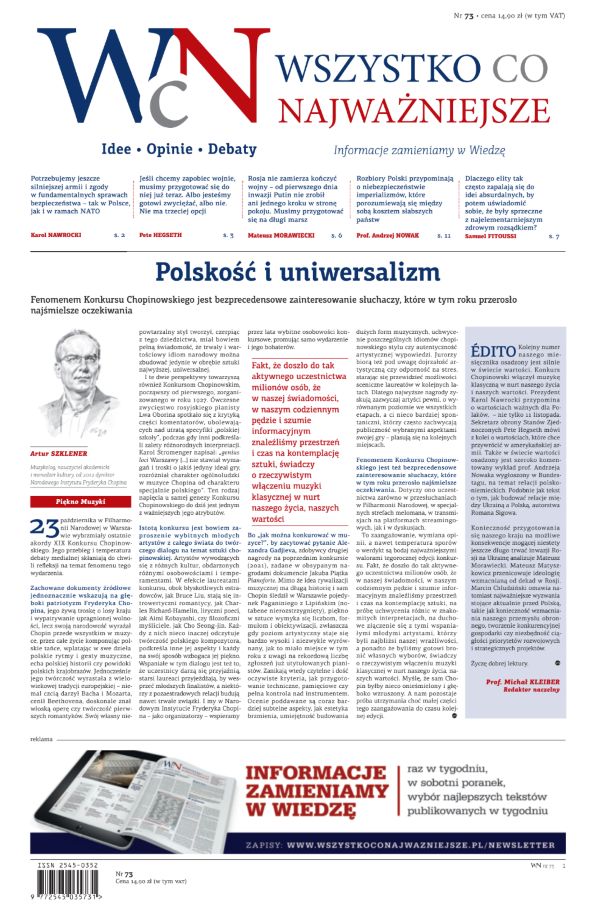 Wrocław is on a roll!
Wrocław is on a roll!
Today, the capital of Lower Silesia can feel lucky. But luck blesses those who seize its offers.
.‘Frankfurt, Wrocław, Luxembourg upstaged their peers’ – these are the opening words of the ‘European Cities and Regions of the Future 2024’ report. It is produced annually by fDi Intelligence, a bimonthly magazine that tracks global economic trends as an international project of the UK’s Financial Times. According to the report, ‘Frankfurt in Germany; Wrocław in Poland; and Luxembourg City, the capital of the namesake country, rose through the ranks to top their respective categories’. This means that a team of experts who monitor the growth of European cities and regions has found that no other city in Europe with a population ranging from 200,000 to 750,000 can rival the capital of Lower Silesia. This applies in particular to the aspects assessed in the report, i.e. economic potential, human capital, lifestyle, cost-effectiveness, connectivity and business friendliness. While it is true that certain cities perform better in some of these sub-categories, the report (which evaluates a total of 330 cities) indicates that none of them, including Zurich, Utrecht, The Hague or other wealthy and picturesque locations in Western Europe, match Wrocław.
The undeniable success of the Lower Silesian capital was neatly summed up by British journalist Daniel Johnson in The Telegraph in May 2023. With undisguised delight, he wrote that ‘a modern metropolis of almost 700,000 people stretches out as far as the eye can see (…) Today, Wrocław has even surpassed the pre-war prosperity of Breslau.’ Let’s add a glimpse of the American perspective, too, by quoting the McKinsey Global Institute’s report of 7 December 2022, which evaluated the quality of life provided by various cities around the world. It records that ‘in 2000, Wroclaw had USD 23,400 in GDP per capita and 74.9 years of life expectancy, similar to living standards in Ensenada on Mexico’s Pacific coast. Twenty years later, the city’s income was USD 55,000 [per capita – author’s note], and its citizens had an average of 79.5 years of life expectancy, comparable to Providence, Rhode Island’. Western experts proclaimed it an impressive leap in prosperity. Wrocław has ‘moved’ from Eastern to Western Europe. To say that it was a success would be an understatement, especially given how quickly it was achieved.
The first 50 years of the city’s history after it was settled by Poles can be described as a slow rise from the ruins left by the Red Army after the Siege of Breslau, when more than 65 per cent of the buildings were burnt down or razed to the ground. Successive communist governments overlooked Wrocław, focusing their central investments on Warsaw, Upper Silesia and the Tricity. Gierek degraded it to the level of but one among 49 provincial cities. Grassroots attempts to break out of the stagnation were always frowned upon in the capital and by the PZPR Central Committee. For the initial 50 years following 1945, the only things that consistently flourished in Wrocław were culture, political breakthroughs and civic activism. Throughout its history, the city has shown courage and determination on multiple occasions, for example, in 1956 and 1968, during the 1980s as a stronghold for the ‘Solidarity’ and ‘Fighting Solidarity’ movements or in the heroic resistance against the millennium flood in 1997. However, this has not translated into wealth. This was especially true in the early years of the Third Polish Republic, when the largest companies, such as Polar, Wrozamet and Pafawag, were on the verge of bankruptcy and had to seek foreign investors. Poland’s only computer manufacturer, Elwro, was sold to Siemens, which then carried out a rapid liquidation of the company. But about three decades ago, a wave of progress began to form, propelling Wrocław towards modernity. In time, it lost its resemblance to a moderately prosperous city in southern Mexico, and its future, according to fDi Intelligence, started to appear more promising than cities like Coventry or Edinburgh.
The shift was initiated when Poland broke away from Moscow’s influence and aligned itself with the Western world, which was followed by a series of political changes. The transformation was then reinforced by the restoration of self-government in the Third Republic of Poland, starting at the commune level in 1990 and expanding through an administrative reform introduced a decade later under Jerzy Buzek’s government. Among other modifications, the reform implemented the direct election of city mayors. Finally, Poland’s entry into the European Union provided another strong boost to the momentum of change. These revolutionary political, organisational and administrative transformations enabled Wrocław to harness yet another asset – its geographical location. Given the city’s proximity to Germany, the companies located in and around Wrocław could easily join the chain of subcontractors and contractors connected to the German economy, both in terms of production and services. The city quickly became part of the economic system of the entire western region.
Large companies recognised the value of this asset. Since the late 1990s, various companies, including Google, IBM, HP Inc., Nokia, Siemens, Credit Suisse and Ryanair, have chosen to invest in Wrocław. The investment boom, as reported by the Wrocław Business Support Centre, has resulted in the creation of 125,000 jobs. The pinnacle of this achievement would be the construction of an ultra-modern Semiconductor Integration and Testing Facility in the Miękinia commune near Wrocław (with an estimated cost of USD 4.6 billion) planned by Intel. The Eurostat data now reveals the tangible impact of the accumulated investments and capital inflows. According to its estimates, in 2023 Wrocław’s GDP per capita was around EUR 40,000. In comparison, the average GDP per capita in eurozone countries is EUR 31,700 (with EUR 35,600 in Germany).
Wrocław is indeed blessed with luck. However, it should be noted that while the same growth wave affected all the cities along the western edge of Poland, only the capital of Lower Silesia has risen so high. Why? fDi Intelligence and other institutions conducting comparative analyses have identified one element that provides the answer: human capital. Ironically, this was the only valuable contribution made by the Polish People’s Republic to the capital of Lower Silesia. With the intention of polonising it as quickly as possible, a Scientific and Cultural Group was established in the spring of 1945, headed by Professor Stanisław Kulczyński, the former rector of the Jan Kazimierz University in Lviv. The Group’s mission was to take control of Wrocław’s cultural assets and quickly attract scholars from the Eastern Borderlands that Poland was losing. The Communists saw the rapid inauguration of the Polish University of Wrocław as a propaganda priority. Thanks to this, the remnants of the intelligentsia from Lviv – and indeed from the whole of eastern Lesser Poland – who had survived the wartime slaughter were not scattered but relocated to Wrocław. There, they had to establish a new life, attempting to recreate a semblance of the esteemed Lviv school of mathematics led by Professor Hugo Steinhaus or the Polish school of immunology pioneered by Professor Ludwik Hirszfeld. It was a hellishly difficult task to carry out during the Stalinist reign of terror, but when the political thaw began in mid-1956, Lviv’s intelligentsia quickly demonstrated their desire to act and make the city a better place. They attempted to accomplish this by establishing organisations such as the Society of Wrocław Enthusiasts, the Committee for the Restoration of the Racławice Panorama or the Society for the Development of Western Land. During the era of the Polish People’s Republic, when all decisions had to be sanctioned by the Central Committee of PZPR, or in fact, the Politburo, efforts from the local community to transform Wrocław into a contemporary metropolis were a futile struggle. But the ideas and the glorification of the memory of Lviv’s intellectual elite outlived communism. Once Poland became free, it began to pay off, leading to an emphasis on education and the promotion of independence and proactive initiatives.
The city’s 30 higher education facilities played an important role in this. They are actually doing quite well considering the conditions in Poland, and they tend to collaborate more often than compete. Wrocław University of Science and Technology performed superbly in the QS World University Rankings by Subject 2023, securing the 340th place in the Engineering & Technology category. It has a lead of 0.9 points over Freie Universität in Berlin. Wrocław University of Environmental and Life Sciences was ranked 351 in the category of Agriculture and Forestry. The result could be better, but local education is not solely judged by international rankings. The Polish Startups 2023 report, prepared by the Startup Poland Foundation, highlights two significant points. Firstly, Wrocław has become the ‘Polish capital of startups’. Twenty-eight per cent of the country’s existing startups are registered in and around Wrocław (whereas in Warsaw, which is twice the size, and in Mazovia as a whole, it is only 19 per cent). Secondly, the city could aspire to the title of ‘Polish Silicon Valley’, with the majority of its startups focused on programming, AI and cutting-edge technologies, particularly in space-related fields such as the design and production of microsatellites, satellites and spacecraft components. Thus, a quarter of a century after the demise of Elwro, Wrocław is once again taking the lead as the capital of Polish modernity.
.Another feature that sets this city apart in Poland is the remarkable ability of its authorities to uphold the initiatives of previous administrations in a truly Western manner. This stands in stark contrast to the realities of the Third Polish Republic, where new leaders often seek to discredit or exclude the accomplishments of their predecessors. Ever since the restoration of self-governance in the Third Polish Republic, Wrocław has had four mayors, all of whom have maintained the approach adopted in the mid-1990s of making the city business-friendly, attracting human capital and providing excellent global connectivity. This consistency is bearing fruit today. On top of everything else, the capital of Lower Silesia is experiencing a growing influx of tourists (1.2 million in 2023, of which 331,000 are international visitors). It is hardly unexpected, as Wrocław is truly one of Poland’s most beautiful cities. It has been blessed with many fortunes, indeed. Most importantly, though, it has always excelled at making the most of them.
Andrzej Krajewski




